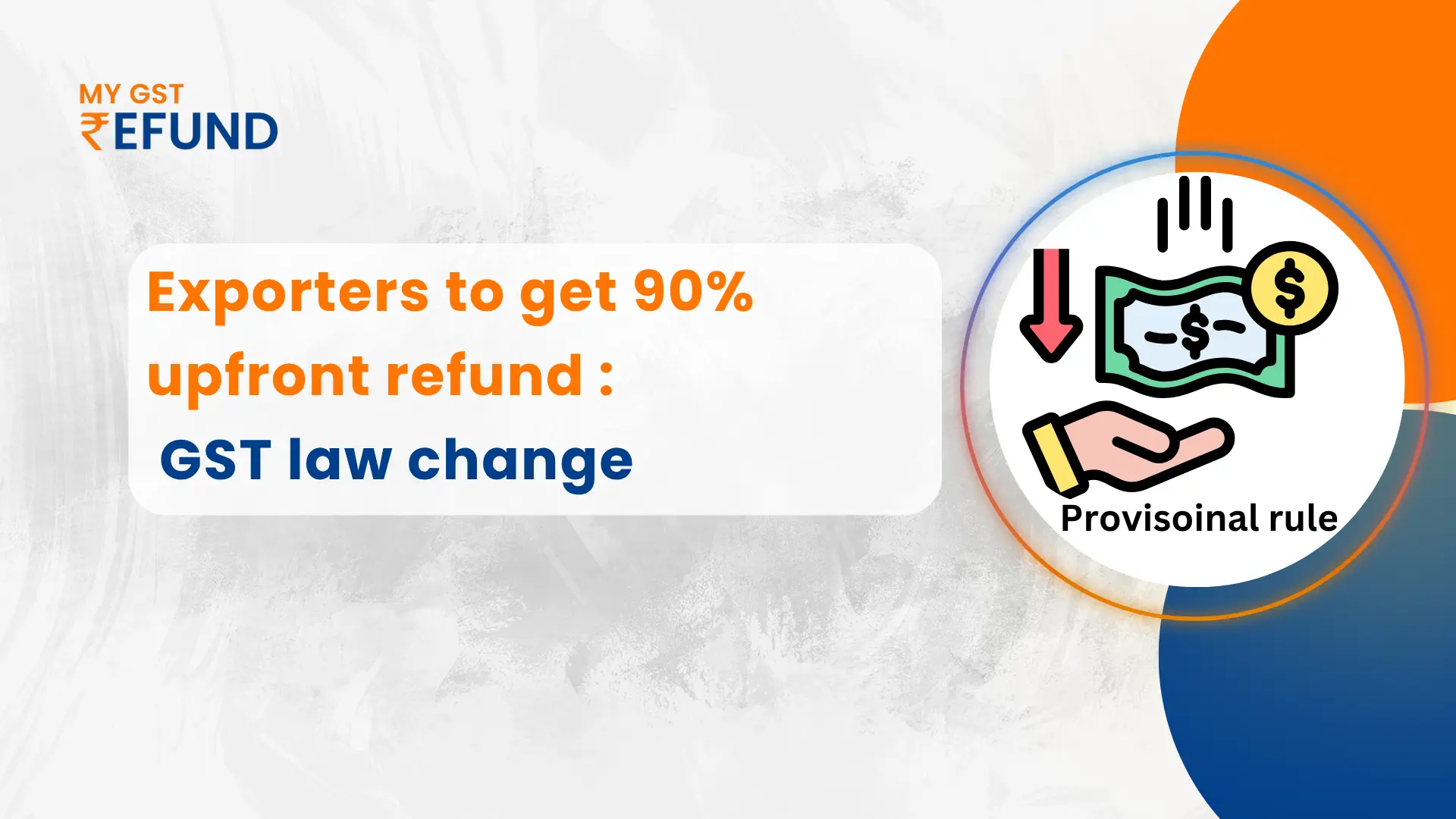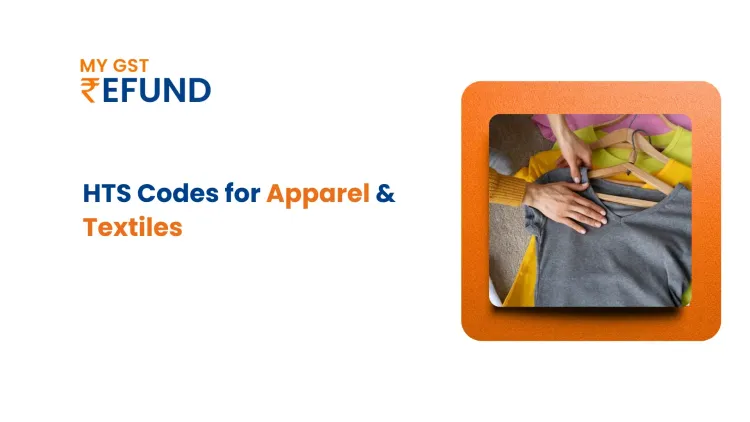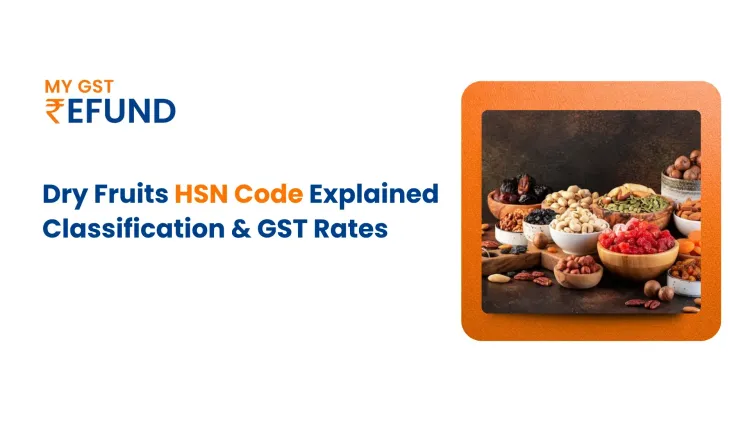90% Advance GST Refund for Exporters: New Relief Under Section 54
Published on: Sat Oct 04 2025
Bio (Reveal/Hide)

The government is in discussion to provide an advance provisional refund of 90% to exporters against their GST claim when filing. The balance 10% will only be provided after the final assessment and reconciliation process has been conducted by the authorities. Learn the GST refund process under Section 54, covering zero-rated supplies, ITC, and the new 90% advance provisional refund rule for Indian exporters.
What is a GST Refund claim?
Refund claim is regulated by Section 54 of the CGST Act. Taxpayers need to make an online application with documents within a period. The process includes examination by tax authorities to ensure the genuineness of the claim before authorization of the refund.
The New Proposal: 90% Advance Refunds to Exporters
Exporters have complained long enough about problems in the existing system, such as delayed refunds and pending claims.
What is covered under "Refund"
"Refund" under Section 54 includes mainly:
- Refund of tax paid on Zero-rated Supplies.
- Tax paid on zero-rated supplies (exports or supplies to SEZ units/developers) of goods or services or both.
- Tax paid on inputs or input services utilized in the manufacture of such zero-rated supplies.
- Refund of tax on Deemed Exports: Tax paid on the supply of goods accounted as 'deemed exports'.
- Refund of unused Input Tax Credit (ITC): As under sub-section (3).
- Refund of Electronic Cash Ledger Balance: Any electronic cash ledger balance.
- Refund of tax paid in error: Tax paid in error on an inter-State supply (IGST) treated as intra-State (CGST/SGST) or vice-versa, under Section 77.
- Refund to certain persons: Tax paid in error by specialised agencies of the UNO, Embassies, or other notified persons.
Time Limit for Claiming a Refund
All such individuals who are entitled to a refund are required to apply within two years from the date applicable.
The "date applicable" varies with varying cases (e.g., date of exportation, date of receipt of payment in convertible foreign exchange for services, due date of return of deemed exports, etc.).
Restrictions on ITC Refund
Refund cannot be granted where the exported goods from India are chargeable to export duty.
The Government may also specify certain goods or services on which the refund of unused ITC due to the inverted structure of duty shall not be granted.
Provisional Refund (Section 54(6))
Where the refund is sought on account of zero-rated supplies, an advance refund of 90% of the claimed amount of refund (without provisionally allowed ITC) is to be made within seven days from the date of acknowledgement of the application for refund, subject to certain terms and verification. The final order is made after final verification.
Time Limit for Sanction
The concerned officer shall have to complete the final order under sub-section (5) within sixty days of receipt of the application in all respects. If no refund order is made within the said time limit, interest shall be charged on the applicant.
The Refund Process: A Step-by-Step Guide
- Application for Refund: The application for refund must be submitted by taxpayers on the applicable form (GST RFD-01) on the GST official website. It should be accompanied by all the necessary documents.
- Acknowledgement of Receipt: Upon successful submission, a Receipt Acknowledgement for the Refund Application (GST RFD-02) will be obtained.
- Review and Temporary Refund: The officer concerned will scrutinize the application and documents produced. A temporary refund of 90% of the amount claimed can be made within a period of seven days from the date of acknowledgement, on fulfilling special conditions.
- Sanction or Rejection: On careful examination, the sanctioning officer shall give sanction for refund and order in Form GST RFD-06, or, where the application is defective, issue a notice to the applicant detailing the defects. The applicant would be given an opportunity to reply prior to rejection.
- Refund Payment: Directly, the refund amount on the sanction shall be debited to the bank account of the applicant.
- De Minimis Amount: For refund claims of two lakh rupees or less, applicants do not need to step forward with advanced documents. They may just produce a declaration based on accounts in their name.
GST Refund Impact on Stakeholders and Sectors
Exporters as a whole -Small, Medium, Large
Most affected sectors under the inverted duty structure:
- Textiles
- Chemicals
- Fertilisers
- Pharmaceuticals
What Exporters Should Do Now under the 90% rule?
- Compliance and Record Maintenance: The refund is issued in advance as an advance refund to relieve, but it might be recovered if the final audit identifies a mismatch.
- Real-time Reconciliation: Mainly verify that all export details reflected under GSTR-1 (Table 6A/6B) are an exact copy of the Shipping Bill (SB)/Bill of Export and the respective GSTR-3B. The only cause for refund being blocked or delayed post-provisional period is discrepancies.
- LUT/IGST Option: Export without paying IGST by using the Letter of Undertaking (LUT) mode so that your working capital remains unencumbered in the first place. In case you also wish to pay IGST, make sure the invoice value, IGST value, and port details are proper and the same in all documents.
- FIRC/BRC for Services: The exporters of services need to possess the Foreign Inward Remittance Certificate (FIRC) or the Bank Realization Certificate (BRC) as irrefutable evidence of realization of export proceeds.
What will be the Financial Strategy to Bridging the Gap 10%
Although the 90% advance refund is a lifesaver of enormous proportions, exporters also need an interim gap plan until the disbursement of the last 10%.
The key takeaways for Export Finance: Approach banks or Non-Banking Finance Companies (NBFCs) proactively and organize export credit (Pre/Post-shipment) or invoice discounting/factoring. The 90% refund really minimizes the risk and capital block, most of the time making these schemes ideal and convenient to avail to be in a position to handle the whole cost of sales effectively.
Bank Account Verification: Verify the bank account of your Customs (ICEGATE) and GST registrations and validate through the Public Financial Management System (PFMS), so that payment failure during the process of refund at the last moment is avoided.
Frequently Asked Questions
Q1. How do exporters become eligible for a GST refund?
Exporters have two primary alternatives, which are otherwise known as zero-rated supplies:
1. Payment of IGST on export: Pay the payment of IGST on goods/services and refund the paid IGST later. The Shipping Bill itself is to be considered an application for refund when submitted successfully for GSTR-1 (Table 6A) and GSTR-3B, and then forwarded to the customs system (ICEGATE).
2. Export on payment of IGST: Export under LUT or Bond and refund of unused Input Tax Credit (ITC) thus generated in respect of exports, by filing Form GST RFD-01 on the GST portal.
Q2. What is the filing due date of a GST refund application?
Refund must be given within two years from the "relevant date". For export of goods, the relevant date is usually the date of departure of the conveyance (ship, aircraft etc.) from India. In export of services, usually, the date of realization of payment in convertible foreign exchange (i.e., BRC/FIRC date).
Q3.Why GST refund delayed or rejected?
The most common reasons are:
- Data inconsistency in GSTR-1, GSTR-3B, and the Shipping Bill/ICEGATE (e.g., invoice number disparity, receipt of IGST amount, or port code).
- Non-updation of Failing Bank Details in the GST portal or ICEGATE.
- Availing ineligible ITC (e.g., ITC against blocked credits).
- Failure to receive the export proceeds (in services) or non-filing of the Bank Realization Certificate (BRC) on time.
Q4. Whether the Input Tax Credit (ITC) can be refunded in case of capital goods on account of exporters?
No, Refund of Input Tax Credit (ITC) on zero-rated supplies is allowed till date only on Inputs and Input Services, but not on Capital Goods. The process prescribed under the GST rule for computation of maximum allowable refund of brought forward ITC (Form GST RFD-01, Statement 3A) excludes ITC on Capital Goods categorically from 'Net ITC.'
Q5. Why Bank Realization Certificate (BRC) is required?
Bank Realization Certificate (BRC) or Foreign Inward Remittance Certificate (FIRC) is the critical document that certifies that payment has been received by the exporter for export of services (and in some cases for goods) in convertible foreign exchange. It is a mandatory document to certify that the supply is an export (zero-rated supply) for claiming the refund of GST.
Q6. What documentation is required for a GST refund audit?
Documents needed are:
- The Refund Application (Form GST RFD-01).
- Copies of GSTR-1 and GSTR-3B of the month.
- Export Invoices and the corresponding Shipping Bills (where goods are involved) or BRCs/FIRCs (where services are involved).
- The Letter of Undertaking (LUT) or Bond copy (where export is made without payment of IGST).
- Working Sheet/Calculation of aggregate amount of refund claimed and explanation of the ITC carried forward.
- Copy of Electronic Credit Ledger for the respective period.
Q7. What are the interest and penal provisions for a delayed refund?
Where the officer in question does not refund within 60 days of the acceptance date of the full application (ARN generation date), the applicant will incur interest at the rate set (6% p.a. currently) from the day following the end of the 60 days to the refund payment date. The department typically does not face penalties for delays, but it must pay compulsory interest.
Q8. Is it possible to combine several tax periods in a single refund application?
Yes. The exporter can, if it so chooses, claim a refund on one financial quarter or on clubbing successive financial quarters. The period aggregate cannot, however, be divided over more than a single financial year. The facility involves an effort of compliance.
Q9. What if my refund application is defective?
Where the original application is defective or incomplete, the officer will issue a Deficiency Memo (RFD-03). The original application is closed on the date of issuing the memo. The new refund application (RFD-01) shall be filed by the exporter, furnishing all the deficiencies noted in the memo. The limitation period of two years runs from the date of the new application.
Related Posts





